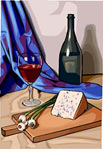Wine tasting
can be broken down into four basic aspects: color, swirl,
bouquet (or aroma), taste and aftertaste.
Color/ Appearence
Color
and appearence is the first thing you notice about a wine.
Color tells you much about the wine. For example, white wines
tend to deepen in color from yellow to golden as they age.
Red wines on the other hand, tend to change from red to brick
with age. The best way to judge a wine's color is by looking
at it against a white background - a white tablecloth or napkin
will do fine. There is a range of colors for both red and
white wine
Swirl
First hold the wine
glass by the stem to avoid getting fingerprints on the bowl
which would otherwise obscure your ability to see the clarity
of the wine. It also prevents white wine from being warmed
up too quickly. Swirling aerates the wine and releases more
aromas or bouquet. Swirl the wine in your glass but don't
get too carried away and splash the person next to you!
Bouquet or Aroma
Did you
know that about 75% of what you'll want to know about a wine
could be found in your nose? You can only perceive four tastes-sweet,
sour, bitter, and salt-but you can smell over 1,000 different
scents. Pinpointing the nose of the wine helps you to identify
certain characteristics found in the taste.
Smell
the wine now that you have released the bouquet. What type
of nose does it have - in other words, what does it smell
like? There must be thousands of adjectives to describe the
bouquet of a wine. Here are just a few to whet your appetite:
Burnt, Fresh, Tannic, Big-full-heavy, Mouldy, Vanilla, Corky,
Nutty, Yeasty, Earthy, Sulphur, Young, Flat, Tannic. Hints:
Aging the wine in oak may add bouquets of vanilla, cinnamon,
cloves and almonds.
Extended
bottle aging may lend a toasty quality. You may smell old
leather or roses. Other grapes have their own trademark aromas:
Zinfandel often evokes berries. You may smell violets and
spice when you encounter Pinot Noir, the primary grape of
Burgundy. Among whites, Chardonnay sometimes smells like ripe
apples and maybe coconut, figs and other tropical fruits,
particularly if it's aged in oak. Riesling, the popular German
grade, may also smell of apples and sometimes citrus fruits.
Sauvignon Blanc often has a grassy smell and sometimes grapefruit.
Your
sense of smell will recognize some of the defects of wine,
such as vinegar (too much acetic acid in the wine); cork (wine
absorbs taste of a defective cork); or sulphur (too much sulphur
dioxide in the wine). Although used in wine making to kill
bacteria and aid in preservation, a good wine should never
smell like sulphur dioxide. Some grapes and winemaking styles
may result in "barnyard' aromas which are not faults.
Taste and Aftertaste/Linger
Tasting
does not simply mean taking a sip of wine and swallowing it
immediately. Humans don't use smell and taste as often as
they use the other senses such as touch and sight. So it stands
to reason that it is more difficult to describe what we taste
in a wine. Used the right way, your mouth can tell you a lot
more about wine than you imagine. Your tongue has five taste
senses - sweetness, acidity, saltiness, touch and bitterness.
You can find them all by letting the wine sit in your mouth
for a few seconds before swallowing.
Try
inhaling some air too before swallowing. It helps release
the wine's flavour in your mouth. You don't actually have
to swallow the wine in order to taste it. Professional wine
tasters simply swirl the wine in their mouths and then spit
it out. They are able to get all the flavour necessary using
this method. Whether you spit or swallow the wine, sit back
and think about it for a little while. Did you like the wine?
Was it acidic? If it was a red wine, were there tannins in
the wine? Were they too strong? How long did the aftertaste
last? Was it a pleasant aftertaste? Wine tasting is all about
your enjoyment regardless of what others think of the wine.
How to read a Wine Label
Top
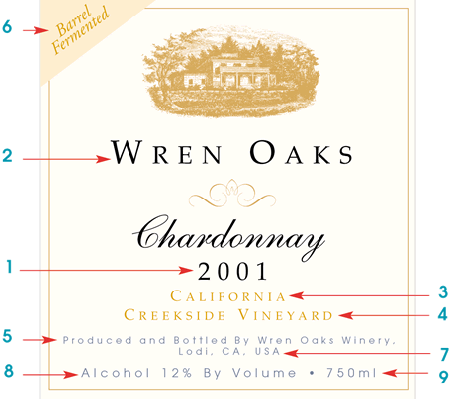
1. This
is the year the grapes were harvested. If the vintage date
appears on the label, at least 95% of the wine must be from
that vintage. Above the vintage year is the grape variety.
If the variety is on the label, the wine must contain at least
75% of the named grape, though many wineries use 100%.
2. Name
of the Winery or brand name.
3. Wine
Region - This tells you where the grapes came from. If the
specific wine region or "American Viticultural Area"
like Napa is on the label, at least 85% of the grapes must
come from that region. If the wine is labeled by county, such
as Mendocino County, a minimum of 75% of the grapes must come
from that county. Even if the wine region on the label is
simply "California," as in many well-priced wines,
you can be assured that 100% of the grapes are from California.
4. Vineyard
- Sometimes you'll see the name of a specific vineyard on
the label, which indicates that a minimum of 95% of the grapes
came from one particular vineyard.
5. "Produced
and Bottled By" indicates that the wine producer also
is the bottler of the wine, and "Estate Bottled,"
means the wine was also made from grapes grown on the producer's
property.
6. Winemaking
Information - Optional terms like "barrel fermented,"
"sur lie," and "oak aged" provide more
clues about the style and flavor of the bottle. All of these
terms point to a toasty, oaky, and more complex wine. Special
tip: Some winemakers include their tasting notes and food
recommendations on the back label.
7. Location
of Bottler - The location of the producer or bottler will
also appear on this line
8. Alcohol
by Volume - In a table wine, the alcohol level ranges from
8.5-14%, give or take a small percentage.
9. Bottle
Size - The volume of the bottle contents. 750 ml is a standard
size bottle and is the equivalent of 25.4 ounces, or about
five glasses or wine.
How to read a French Wine Label
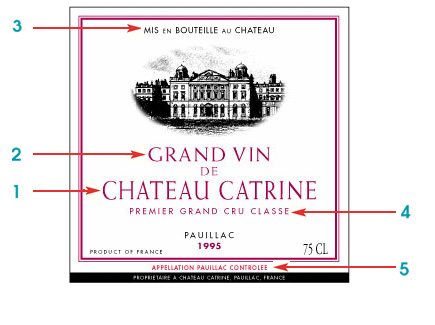
1. Chateau
Catrine - Name of the Producer
2. Grand
Vin - Indicates this is the main wine bottled at the chateau
3. Mis
En Bouteille Au Chateau - Indicates the wine was bottled at
the Chateau
4. Premier
Grand Cru Classe - Indicates the status of the wine according
to the classification in this case the highest classification.
Premier Grand Cru Classe" tells us this chateau was one
of the five original "First Growth" chateau from
the Classification of 1855.
5. Appelation
Pauillac Controlee - Indicates the wine is produced under
the AOC (Appellation d'origine Contrôlée) regulations
fo rthe region, in this case Paullac. AOC is just one category
of quality for French wine. The VDQS (Vin Délimité
de Qualité Supérieure) is a designation just
below AOC, and is usually a temporary designation for smaller,
experimental wine regions that are eventually granted full
AOC status.
How to read an Italian Wine Label
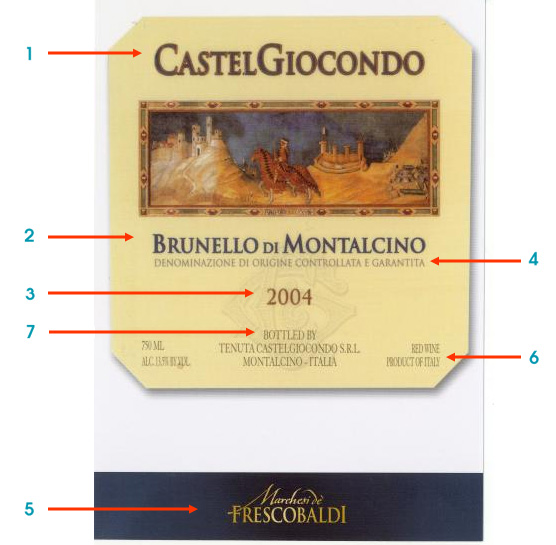
1. Castel
Giocondo- Estate name
2. Brunello
Di Montalcino - Wine type or region
3. 2004
- Vintage year
4. Denominazione
di Origine Controllata e Garantita (DOCG), the most stringent
Italian classification. Similar to the DOC but more stringent.
Allowable yields are generally lower, and DOCG wines must
pass an evaluation of a tasting committee before they can
be bottled. Other classifications include Vino Da Tavola,
Vino a Indicazione Geografica (IGT) and Vino a Denominazione
di Origine Controllata (DOC).
5. Frescobaldi
- The wine producer
6. Product
of Italy - The country of origin
7. Bottler
information
How to read a German Wine Label
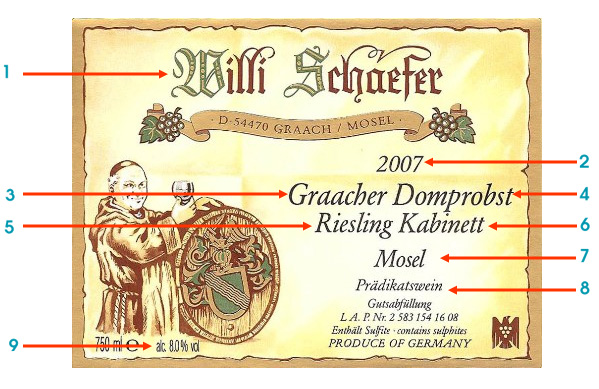
1. Willi
Schaefer - Producer
2. 2007
- Vintage year
3. Graacher
- Village
4. Domprobst
- Vinyard
5. Riesling
- Grape Varietal
6. Kabinett
- The Prädikatswein (formerly QmP) Kabinett
- fully ripened light wines from the main harvest, typically
semi-sweet with crisp acidity, but can be dry if designated
so.
Spätlese - meaning "late harvest"
typically semi-sweet, often (but not always) sweeter and fruitier
than Kabinett. Spätlese can be a relatively full-bodied
dry wine if designated so. While Spätlese means late
harvest the wine is not as sweet as a dessert wine.
Auslese - meaning "select harvest"
made from selected very ripe bunches or grapes, typically
semi-sweet or sweet, sometimes with some noble rot character.
Sometimes Auslese is also made into a powerful dry wine, but
the designation Auslese trocken has been discouraged after
the introduction of Grosses Gewächs. Auslese is the Prädikat
which covers the widest range of wine styles, and can be a
dessert wine.
Beerenauslese - meaning "select berry
harvest" made from individually selected overripe grapes
often affected by noble rot, making rich sweet dessert wine.
Eiswein (ice wine) - made from grapes that
have been naturally frozen on the vine, making a very concentrated
wine. Must reach at least the same level of sugar content
in the must as a Beerenauslese. The most classic Eiswein style
is to use only grapes that are not affected by noble rot.
Until the 1980s, the Eiswein designation was used in conjunction
with another Prädikat (which indicated the ripeness level
of the grapes before they had frozen), but is now considered
a Prädikat of its own.
Trockenbeerenauslese - meaning "select
dry berry harvest" or "dry berry selection"
made from selected overripe shrivelled grapes often affected
by noble rot making extremely rich sweet wines.
7 . Mosel
- Wine Region
8 . Prädikatswein
- Quality designation. Deutscher Tafelwein,
or 'German table wine' equivalent to vin de table
Deutscher Landwein, or 'German country wine'
equivalent to vin de pays introduced in 1982 must come from
one of the 19 Landwein regions.
Qualitätswein
bestimmter Anbaugebiete (QbA), or quality wine ust
be produced exclusively from allowed varieties in one of the
13 wine-growing regions. Qualitätswein plus the name
of the region, rather than the full term Qualitätswein
bestimmter Anbaugebiete is found on the label.
Prädikatswein, recently (August 1, 2007)
renamed from Qualitätswein mit Prädikat (QmP). The
top level of the classification system. Prädikatswein
range from dry to intensely sweet.
9 . Alcohol
- in this case 8%
Wine Vintage Charts
Here are a few reference vintage charts from
various sources. Each is in a PDF form. The Spector card is
formatted to be used as a pocket guide.
Wine
Spectator 2010 Vintage Chart
Wine
Spectator 2012 Vintage Chart
Robert
Parkers' The Wine Advocate Vintacge Chart 2009
Robert
Parkers' The Wine Advocate Vintacge Chart 2012
Wine
Enthusiast 2010 Vintage Chart
Wine
Enthusiast 2012 Vintage Chart
QRW 2010 Vintage
Chart
What's in Oak that affects Wine?
Top
Lactones
Lactones are the
most important oak derived flavors in wine and are known as
oak lactones. On their own the oak lactones smell like coconuts,
but in wine they smell oaky too. The two main types are known
as 'cis' and 'trans' isomers of B-mthyl-y-octalactone. The
seasoning affects the ratio of cis to trans oak lactones and
toasting reduces the overall lactone levels. Trans has a coconut
aroma, while cis has coconut and earthy herbaceous characteristics.
American oak is much higher in lactone concentrations.
Vanillin
The component behind
vanilla is present in significant quantities in oak. If the
oak is actually fermented in contact with oak, the yeast used
in fermentation reduces the vanillin concentration. Thus barrel-fermented
wines smell less vanilla and oaky even though they are often
in oak for longer.. Levels of vanillin increase with mild
toasting but can decrease with heavy toasting.
Guaiacol
Guaiacol has a
smoky aroma and is also described as spicy. It is formed by
the degradation of the wood component lignin during toasting
and therefore increases at high toasting levels.
Eugenol
Eugenol is a clove-like
smell. It increases with seasoning and toasting.
Furfural-5-methylfurful
Furfural-5-methylfurful
is produced by the heat induced degradation of sugars and
carbohydrates during toasting. They have a sweet butterscotch
and caramel aromas with a hint of almond.
Ellagitannins
Tannins absorbed
by the wine from the wood are known as ellagitannins. They
modify the structure of the wine and increase the color of
the wine. They have an astringent taste. The concentration
decreases at heavy toasting levels.
Many of
these compounds occur at levels below their individual detection
thresholds in wine. However they can have a synergistic effect
on the flavor and aroma of wine. For example, the perception
threshold for oak lactones is reported to be 50 times lower
in the presence of vanillin. In addition the combination of
more than one of these can produce complex flavors or aroma
sensations. Whether or not any of these flavors will be positive
depends upon the context of the wine
Helpful Wine Terms/Glossary
Top
Acidity
A wine's acidity should be detectable as a sharpness in the
mouth, particularly around the front sides of the tongue.
It should be neither too obvious nor absent. It provides a
refreshing sensation in white wines, and balance in reds.
Its absence makes a wine dull and 'flabby' - a defect in any
wine, but a disaster in sweet wines which to me become undrinkable
without balancing acidity. Too much acidity can make a wine
difficult to drink. There are many acids in a wine, but the
principle ones are acetic, malic, tartaric, lactic, citric
and carbonic acid.
Austere
A term used to describe a wine that is unforthcoming - often
they are young, tannic wines. They give little pleasure at
the time, but it is likely that they will improve with age.
Balance
A tasting term. Wines said to have balance have a harmonious
combination of tannin, acidity, texture and flavor. This is
a vital attribute
Bâtonnage
The term for stirring of the lees which is employed to impart
body and flavor to the wine.
Blind
tasting
If you're ever poured a wine without knowing what it is, this
is a blind tasting. The advantage of a blind tasting - usually
achieved by simply covering the label - is that it removes
all prejudices about the wine, and you have to judge it entirely
on its merits
Body
A tasting term. A wine with plenty of flavor, alcohol, extract
and tannin may be described as full bodied. It is a less specific
term than texture
Bordeaux
The 1855 classification system was made at the request of
Napoleon III for the Exposition Universelle de Paris. This
came to be known as the Bordeaux Wine Official Classification
of 1855, which ranked the wines into five categories according
to price. The first growth red wines, are among the most expensive
wines in the world. The five first growthsThe first growths
are:
Château Lafite-Rothschild, in the appellation Pauillac
Château Margaux, in the appellation Margaux
Château Latour, in the appellation Pauillac
Château Haut-Brion, in the appellation Péssac-Legonan / Graves
Château Mouton Rothschild, in the appellation Pauillac, promoted from second to first growth in 1973.
At the same time, the sweet white wines of Sauternes and Barsac were classified into three categories, with only Château d'Yquem being classified as a superior first growth.
In 1955, St. Émilion AOC were classified into three categories, the highest being Premier Grand Cru Classé A with two members:
Château Ausone
Château Cheval Blanc
There is no official classification applied to Pomerol. However some Pomerol wines, notably Château Pétrus and Château Le Pin, are often considered as being equivalent to the first growths of the 1855 classification, and often sell for even higher prices.
Botrytis
cinerea
The cause of Noble Rot, Botrytis cinerea is a fungus which,
under suitable conditions, attacks grapes on the vines, leaving
them shriveled and dehydrated. For many grapes this can be
a disaster, but the process is also invaluable in the production
of sweet wines in Bordeaux, Austria, Germany and Tokaji. In
unfavorable conditions the fungus is the cause of Grey Rot.
Brettanomyces
A fungal infection. The Brettanomyces fungus can originate
in the vineyard but some wineries are chronically contaminated,
the organism living in oak barrels or even on the wooden structure
of the winery itself. As a consequence the wines from this
vineyard can bear a Brett profile - farmyardy, horsy, sometimes
metallic aromas - year after year. Examples of châteaux
which are renowned for Brett contamination are Beaucastel
(Châteauneuf du Pape, Rhône Valley) and Talbot
(St Julien, Bordeaux).
Brix
A measure of sugar content in grape juice, used particularly
in the New World. My article on must weight in my Sweet Wine
series gives more information.
Closed
A tasting term to describe a wine where there is no, or very
little, aroma or flavor. Many wines, after the exuberant flavors
they offer in youth, 'close down' in this way before they
'open out' again as they enter a mature phase
Corked
A tasting term used to describe wines contaminated by trichloroanisole
(a corked wine is not one with bits of cork floating in it).
This chemical compound is the product of mould infection in
the cork. Said to affect 5% of bottles (some say more, some
less) it is one of the main reasons behind the drive towards
the increasing use of screw caps and synthetic closures. It
may result in a wine that simply lacks fruit and can be difficult
to spot, or it may be horribly obvious, with cardboardy, musty,
mushroomy, dank aromas and flavors, rendering the wine completely
undrinkable. See my advice page on faulty wine for more information.
I also keep a record of corked wines experienced, mainly because
it is so annoying
Dry
A tasting term. Essentially this is the opposite of sweet,
although a wine that tastes dry still contains sugar, perhaps
just a few grams per litre. The term 'dry' can also be used
to describe the tannins or mouthfeel, when it refers to the
dry, puckering sensation the wine imparts
Finish
A tasting term. The finish is how the wine tastes at the point
of, and just after, swallowing. After finish comes the length
Fortification
The process of adding spirit to a wine. If this is done before
completion of the alcoholic fermentation, as with Port, the
unfermented sugars will cause the wine to be sweeter than
would otherwise be the case. Added later, as is the case with
Sherry, the wine will remain dry. In all cases the final alcohol
content receives an obvious boost. The process is also used
in the production of vin doux naturel.
Forward
A tasting term. This denotes a wine which is felt by the taster
to be developing quickly, and is ready to drink before it
might otherwise be expected. The opposite of backward
Integrated
A tasting term. When the components of wine, such as tannin,
oak and acidity, fade as the wine develops, they are said
to have integrated.
Left
Bank
A collective term for the communes of the left bank of the
Gironde in Bordeaux. Left Bank wine is predominately Cabernet
Sauvignon, and the Right Bank is predominately Merlot.
Legs
A tasting term. It refers to the tear-like tracks that a wine
makes down the side of a glass after it has been swirled.
It may be related to alcohol or glycerol content - it's a
matter of contention. Not really essential for assessing the
quality of a wine, although some tasters do still pass comment
on the legs.
Midpalate
A tasting term. After taking a mouthful, hold it in the mouth,
and see what you get from the wine. Does it have enough flavor
and texture? What are the tannins and acidity like? When describing
how the wine develops in the mouth, you are describing the
midpalate. Describing your immediate impression would be to
discuss the wine's entry. Then swallow, to judge the finish
and length.
Noble
Rot
A fungal infection caused by Botrytis cinerea. Under the right
conditions - damp, misty mornings followed by warm, sunny
afternoons - the result is Noble Rot, which leaves grapes
shriveled, dehydrated, and thus rich in sugar and also unique
Botrytis-derived flavors. It is an essential ingredient in
Sauternes, Tokay and other sweet wines of Germany and Austria.
Under the wrong conditions the result of infection is Grey
Rot. See my feature on Noble Rot for more detailed information
Nose
A tasting term. The 'nose' of a wine describes how a wine
smells
Oxidation
The degrading action of oxygen on a wine (or any other substance)
is known as oxidation. Hence exposure of the wine to oxygen
in the winery is carefully controlled, although not necessarily
completely avoided. Exposure to oxygen during racking and
ageing in barrel can be of benefit to the wine. Once a bottle
of wine has been opened for some time, or if oxygen has seeped
past a faulty cork, the oxidized wine will taste off
Right
Bank
A collective term for the communes of the right bank of the
Gironde in Bordeaux. Right Bank wine is predominately Merlot
Structure
A tasting term. When a wine is described as having structure,
the taster is referring to the tannin and acidity levels.
These elements give the wine a presence in the mouth; without
them wine would tend towards a flabby, fruit flavored drink.
Tannin
Found in grape skins, pips and stalks, tannins are harsh,
bitter compounds which if present in large amounts make a
wine difficult to drink as they leave a dry, puckered sensation
in the mouth - rather like drinking stewed tea, which is also
very tannic. The amount of tannin can be increased by enhancing
extraction, achieved by prolonging the cuvaison. Tannins may
also enter the wine from oak barrels. Tannic wines are generally
destined for ageing, the tannins polymerizing to form sediment
with time.
Texture
The texture of a wine describes how the wine feels in the
mouth - is it silky, velvety, rounded, or smooth? It is a
more specific term than body, which describes the general
impact of the wine
Toasty
A tasting term. Toasty means literally means just that - smelling
or tasting of toast. It may reflect 'toasting' of the barrels,
when they may be placed around a fire (sometimes as they are
made), the flames altering the physical and chemical composition
of the surface of the wood, and subsequently this will have
a significant effect on the flavor of the wine.
Top
Wine Storage Tips
Temperature
This
is certainly the greatest concern when cellaring wine. Room
temperature is usually in excess of 72ºF, great for humans
but rapidly lethal when it comes to wine. The temperature
inside the average home is also very variable, with most rooms
warming rapidly during the day. This is also true in the kitchen,
where many people seem to store wine, at least in the short
term. Here the ambient temperature varies significantly. This
inconstancy of temperature is not recommended for wine storage.
The ideal temperature is 50ºF to 55ºF, but several
degrees either side of this is quite safe. In fact, provided
the wines do not freeze, which does not occur until the temperature
drops some way below 32ºF, then it is quite safe for
temperatures to drop lower than the ideal. The worst that
may happen is that some non cold-stabilized wines may throw
a small deposit of harmless tartrate crystals, which is of
no real consequence. It is worth remembering, however, that
one of the purposes of cellaring wine is so that it develops
over time, gracefully maturing into something more complex
and interesting than the wine in its youth. Lower temperatures
inhibit this process, meaning you will have to wait even longer
to enjoy the wines at their peak. A little above 55ºF
is also quite safe, and I would be happy with wines stored
medium term in temperatures up to about 60ºF. This will
not spoil the wines at all, but as you may expect warmer temperatures
may accelerate the ageing process.
Humidity
A moderately
damp cellar is ideal, as humidity helps to keep the corks
from drying out. This is also achieved by keeping the bottles
horizontal, so that the wine is in constant contact with the
cork. A cork that is kept moist keeps its shape, and thus
remains well expanded and maintains a good seal. Although
it is not too difficult to get around the problem of a cellar
with humidity that is too low, a cellar that is too damp is
more difficult to rectify.
Light
Darkness
is ideal for a cellar. Ultraviolet light destroys wine, which
is one of the reasons wine is traditionally bottled in colored
glass. Consequently it makes sense to store wine away from
the potentially damaging effects of such light sources.
Vibration
Wine
needs to sleep, and frequent disturbance of the wine will
agitate it. This is unlikely to be a significant problem in
the modern home, the small and occasional vibrations from
domestic appliances being too slight to cause any real problem
A Guide on White Wine Grape Types
Chardonnay
Profile: The variety itself is thin-skinned and gives good
yields. Other than Burgundy and Champagne, the grape has found
fame on the labels of wine from Australia, New Zealand, California,
South Africa, South America, Eastern Europe, Southern France
and even Italy. It would have been quicker to list where the
grape isn't extensively cultivated.
The characteristics
of the wines produced vary considerably, and many aromas and
flavors to be found are often down to oak ageing rather than
the grape variety. These include, butter, vanilla, spice,
toast and mealiness. The grape itself can give rise to a buttery
feel, but also flavors of apples, lemons, melon, honey, mango,
fig, hazelnut, mineral, pineapple and other tropical fruits,
particularly from warm, New World climes. Other characteristics
include wet wool (especially Burgundy) as well as minerals
and flint (especially Chablis).
Sauvignon Blanc
Profile: This grape is responsible for some of the fine wines
of the Loire Valley, with such well-known names as Sancerre
and Pouilly-Fumé. To the modern wine drinker, however,
it is probably better known as the grape behind the richly
flavored wines that have put New Zealand on the wine map.
It also, however, has an important role to play in Bordeaux
where, together with Semillon, it is used to produce Sauternes,
the fine botrytis-influenced dessert wine of the region. This
is a thin-skinned variety, and is therefore susceptible to
botrytis infection (although less so than Semillon).
Characteristics
of the grape when used to produce a dry wine include cut grass,
minerals (especially Sancerre), gunflint and cordite (especially
Pouilly), gooseberries, lantana, tomato bush, artichoke, pea
pods, dill, green apple, flint, gunpowder, gooseberry, grapefruit,
passionfruit, tropical fruits (especially new Zealand).
Riesling
Profile: This grape, which will grow in a wide range of conditions,
is most famous for producing some of the finest white wines
in the world when it is grown on the steep, slate vineyards
that lie on the banks of the Mosel in Germany. This grape
is also grown in Alsace, where although produced in a very
different style it is also responsible for some very fine
wines. Plantings in the New World are increasing, with some
success in particular from New Zealand and Australia.
Characteristics
include floral aromas, fruit blossom, apples, lemon, limes,
other citrus fruits, tropical fruits (especially New World),
as well as slate, minerals and petrol (especially Germany)
jasmine, rose, honysuckle, cold cream, bath salts, kerosene
and flint.
Semillon
Profile: One of two grapes, together with Sauvignon Blanc,
that is responsible for Sauternes. Like Sauvignon, Semillon
is thin-skinned and thus susceptible to Noble Rot (botrytis)
infection. Unfortunately it is also susceptible to Grey Rot,
which does not have the beneficial effects of the more noble
infection. Other than in Bordeaux, Semillon is little grown.
Nevertheless it has found a niche in the Hunter Valley in
Australia, where unoaked versions are capable of long ageing,
developing fabulously rich flavors as they do so.
Characteristics
from dry wines include a waxy texture, butter, honey, green
bean, cut grass, pear, hay, toast, lanolin, limes and citrus
fruits, lemon curd or meringue. Typical Sauternes often tastes
of pineapple, quince and other rich fruits, alongside the
botrytis.
Viognier
Profile: In recent years Viognier was at risk of extinction,
with just a few hectares maintained in the fine Northern Rhône
appellation of Condrieu. These wines were not widely appreciated
despite, in some cases, being extremely fine. In recent years
though, many wine makers in Languedoc-Roussillon and the New
World have latched on to this grape and plantings are increasing
dramatically. These New World examples, if well made, will
make a welcome alternative to the excellent although usually
expensive Condrieu bottlings. Many have hailed the grape as
the 'new Chardonnay' and I would not be surprised if it becomes
as well known, even if it is more difficult to pronounce!
Characteristic
flavors and aromas include peaches, apricots, musk, iris,
ylang ylang, orange blossom, lychee, marmalade, pine nuts
and kernels. Problems with some New World wines include lack
of balance due to excessive alcohol.
Chenin
Blanc
Profile: This grape is responsible for some of the finest
dessert wines in the world, from numerous appellations in
the Loire Valley, including Bonnezeaux, Quarts de Chaume,
Vouvray and Coteaux du Layon. It also produces some dry wines
in the Loire, and is also widely planted in South Africa,
where it is known as Steen, although these wines are of much
less significance. Like some other grapes above, this thin-skinned
variety is also prone to botrytis.
Typical
characteristics of the sweet wines of the Loire include quince,
honey, hay, cut grass, herbal tea and minerals
Other
White wine grapes
Gewurztraminer:A
superb grape which produces fine wines in Alsace. Some love
it, some hate it. There has been limited success in the New
World, particularly New Zealand. Characteristics: spice, bacon,
banana, rose, musk, mango, lavendar, guava, lychee, grapefruit
and is sometimes troubled by low acidity.
Pinot Gris: Another of the top grapes of
Alsace (where it is often called Tokay Pinot Gris), this also
produces fine, spicy wines, with better acidity than Gewurztraminer.
Also found in Italy (as Pinot Grigio) and Eastern Europe.
Characteristics: spice, bacon, tropical fruits.
Muscat:
The final variety in this trio of Alsatian grapes. Also found
in the Southern Rhône where it is used for dessert wines,
as well as Australia, where some exceptionally fine liqueur
wines are made. Characteristics: musk, sometimes grapey, orange
and citrus peel, floral and aromatic.
A Guide on Red Wine Grape Types
 Cabernet
Sauvignon
Cabernet
Sauvignon
Profile: Renowned for the wines it produces on the well-drained,
gravelly soils on the left bank of the Gironde
in Bordeaux, cabernet Sauvignon has been a natural choice
for New World winemakers. It is a robust grape that has travelled
well, and is now cultivated in Australia, South Africa, North
America and South America, but has also been put to use in
Italy, Spain and Eastern Europe.
It has
small, blue-black berries which have thick skins, providing
necessary tannin, color and flavor. Characteristics aromas
and flavors are blackcurrants, cedar, old furniture and cabinets,
coffee, tobacco, cigars, cigar boxes, violets, minerals, green
pepper (especially if grapes are somewhat under-ripe), chocolate
and so on. Young
wines start off intensely fruity, while the more complex aromas
will develop with age.
Merlot
Profile: Whereas Cabernet Sauvignon has its roots from the
left bank communes of Bordeaux, Merlot is most famous for
the wines from the right bank, especially
from Pomerol and St Emilion. Although somewhat less widely
travelled when compared to Cabernet, this thin-skinned, large-berried
variety has found a new home in California. It is also important
in some of the top wines of Italy, and can also be found in
Australia and Eastern Europe.
Spicy
fruitcake, Christmas cake and chocolate characteristics will
often give Merlot away, although it may also display blackcurrant,
sage, anise, beet root, mint, black cherry and plums. It is
less tannic than Cabernet Sauvignon, and is often used when
wine need to be 'fleshed out' in weaker vintages.
Pinot
Noir
Profile: This variety is thin skinned, grows in small bunches,
and is prone to problems with yields. Accepted wisdom states
that consistently low yields are necessary to maintain quality,
and although high-yield clones have been developed (there
are many different clones of Pinot Noir, all of which have
different flavor, yield, disease resistance and so on) the
final product lacks the necessary quality.
When discussing
Pinot Noir, it is also worth remembering that it plays a vital
role as one of the three grapes widely planted in Champagne.
Primary aromas and flavors (those present when young) are
redcurrants, cranberries, strawberries, blackberries, rose
petals, cola, spice, rhubarb, forest floor and chocolate.
Syrah/Shiraz
Profile: Syrah is the grape behind fine wines of the Northern
Rhône, not only Côte Rôtie ("roasted
slope") and Hermitage, but also Cornas and Crozes-Hermitage.
Nevertheless, most wine drinkers are familiar with it as Shiraz,
the name by which it is known in Australia, where it is responsible
for richly fruity wines, ranging from inexpensive everyday
bottles right up to Australia's first growth, Penfolds Grange
(once known as Grange 'Hermitage'). This thick-skinned grape
may produce potentially tannic and long-lived wines. It is
also late-ripening, explaining why it has gravitated towards
warm regions such as the Rhône and Australia, although
it is also producing good wines in South Africa, Chile and
California.
Typical
descriptors include black fruits and black pepper, but more
intriguingly raspberries, spice, herbs, grilled meats, black
olive, jammy, menthol, eucalyptus, licorice, leather, charcoal,
smoke and tar may be found.
Sangiovese
Profile: This variety enjoys a warm climate, and is capable
of producing great wines in such conditions. A cooler environment
may result in excessive acidity. Despite this, Sangiovese
has not been the focus of the attention of new World winemakers
in the same way as Cabernet or Pinot. Sangiovese is also the
grape behind other classic wines of Northern Italy, such as
Brunello di Montalcino (Brunello being an Italian synonym
for this grape) and Vino Nobile di Montepulciano. In the New
World, there are some small plantings in California and Australia,
as well as Argentina.
Typical
characteristics include slightly bitter, mouth-watering sour
cherry and black cherry aromas, plumb, spices, herbs and tobacco.
Nebbiolo
Profile: Like Sangiovese, Nebbiolo is another of Northern
Italy's classic grapes which, despite great potential, and
being responsible for some of Italy's finest wines, has not
been widely planted in the New World. It's home is not just
in Barolo, but also nearby Barbaresco, where fine wines are
also produced. It would seem ideally suited to planting in
warmer climes, as this thick-skinned variety is late ripening.
Indeed, the name Nebbiolo may be derived from nebbia, a fog
which hangs over the vineyards during the Autumn harvest.
There are small plantings, however, in California, Australia
and Argentina.
Typical
adjectives used to describe the wines of the Nebbiolo grape
include black cherries, liquorice, green tea, dried rose or
violet, camphor, plum, anise, truffle, tar, hung game and
chocolate
Other Red Grapes
Grenache: Important in the Southern Rhône,
where it dominates. Nevertheless, in almost all cases in is
blended with other varieties such as Syrah and Mourvèdre,
which is standard practice in this region. It may also be
found in Spain and Australia. Characteristics: raspberries,
white pepper, bubble gum, cherry, orange peel, earth and prune.
Mourvèdre: Also important in the Southern
Rhône, but also Bandol in Provence where it produces
some classic wines. Also known as Monastrell or Mataro, and
may be found in Spain and California. Characteristics: tannic,
long ageing wines. Black fruits.
Cabernet Franc: Dominant grape in the Loire
Valley, but also extremely important in Bordeaux where it
is general used as a minor component of the blend by most
châteaux, although by itself it is the grape behind
the wine from one of the regions top estates, Cheval Blanc.
Characteristics: blackcurrants, blackcurrant leaves, green/bell
peppers, tarragon, mint, pencil shavings, smoke, spice.
Tempranillo: The grape of Rioja. Many of
the characteristics of Rioja are derived from the long oak-ageing.
Characteristics: vinified without oak, you might find strawberries,
plum, brown sugar, raspberry, earth and soft spices.
Malbec: Like Cabernet Franc, this is used
as part of the blend by some Bordeaux estates. It is also
the grape behind Cahors, a southern French appellation. It
is becoming more widely known, however, for the steadily improving
wines it is producing in Argentina. Characteristics: intense
summer fruits, spice.
Zinfandel: The grape the USA has made its
own, with wide plantings in California especially. It is also
grown in southern Italy where it is known as Primitivo. Characteristics:
red and black fruits, black pepper, tomato, walnut, raisin,
tar and briar.
Pinotage: This grape belongs in South Africa.
It is a crossed variety, the parents being Pinot Noir and
Cinsault, which was once known as Hermitage. Characteristics:
summer fruits, fruitcake, tar, leather, smoke.
Gamay:
The grape of Beaujolais. Like Tempranillo, many of the flavors
associated with this grape are not from the grape itself.
In Beaujolais, the winemaking technique carbonic maceration
is more the culprit. Certain yeast strains have also been
implicated as being responsible for some flavors, particularly
banana. Characteristics: red fruits, bananas, bubblegum.
Information on
Wine Glasses
Which sizes brings the appropriate intesity
of aromas for different wines
Which shapes direct wines to specific parts of the tongue
Which shapes and sizes emphasize fruitiness
Which shapes and sizes emphasize tannin
Which shapes keep Champagne from going flat
Below are some sample wine glasses with the
corresponding wines from the Riedel glass company.
White Wine Glasses
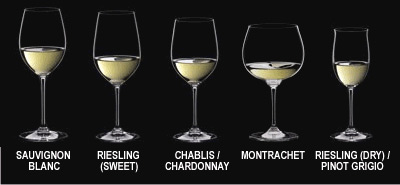
Red Wine Glasses
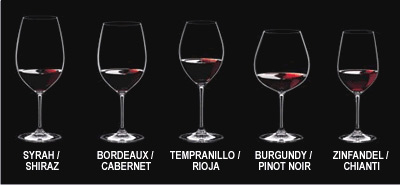
Champagne and desert wine glasses
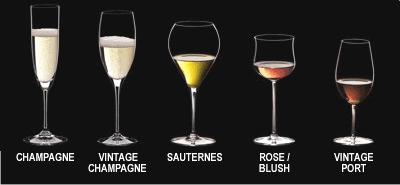
Wine Spectator top 100
The
2009 Wine Spector Top 100 List
The
2010 Wine Spector Top 100 List
The
2011 Wine Spector Top 100 List
Other Wine Related Information and
References:
Do
more expensive wine taste better?
How
to start a wine Cellar
Taxes by state
Click
here to join

All
About the Wine.

Phone: 954-383-7911

